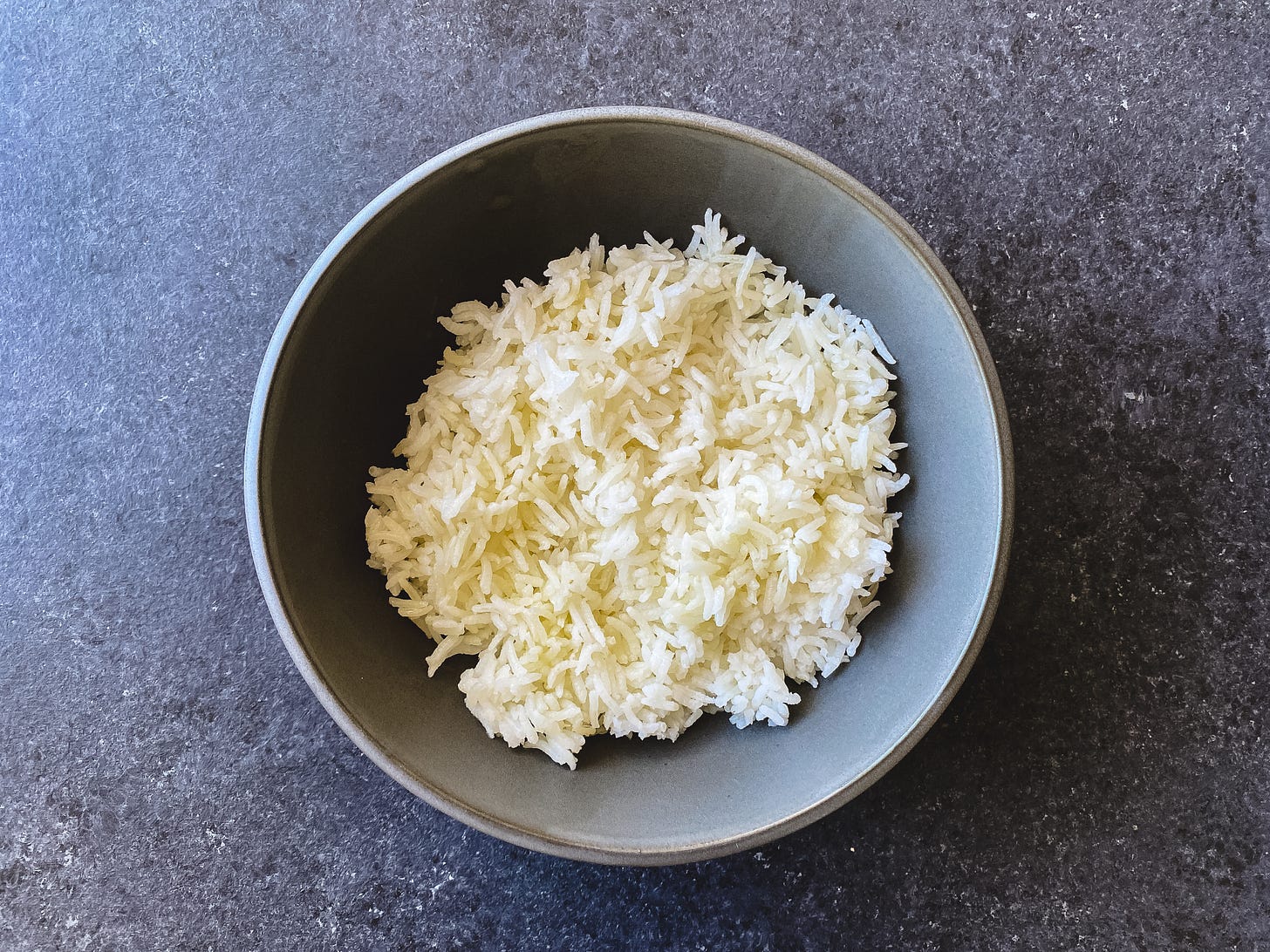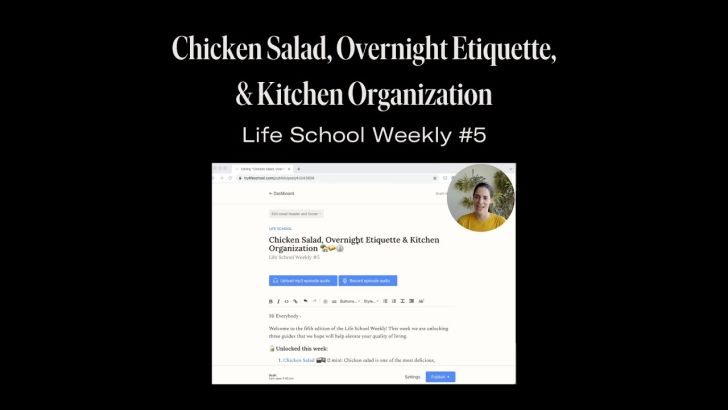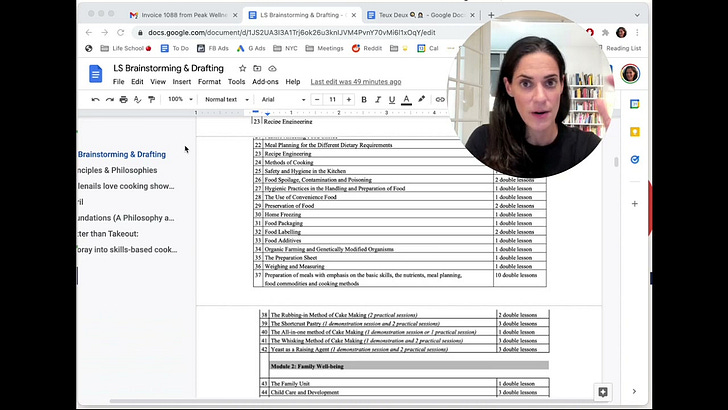This lesson is 926 words, a 3 min and 42 second read time. It is part of How to Boil Water, as well as the MaxF Meal Prep Collection.
📍 Introduction
Versatile, easy to store, economical, and delicious, rice is a staple of home chefs worldwide. Feeding more people in the world than any other crop, it's no surprise that rice is highly convenient. Whether used as a main ingredient, side, or base, rice adds a scrumptious fluffy texture to almost any dish.
Requiring only water, a pot, and a dash of patience, rice is an ideal ingredient for maximum efficiency meal prep. Go ahead, put the lid on, and let the steam get to work. You'll be fluffing the rice before you know it.
🛒 Ingredients
Rice
Kosher Salt (optional)
⏲ Instructions
Wash the Rice (~30 seconds)
Pour rice into the cooking vessel (e.g., pot, rice cooker insert)
Fill with water & swish with your fingers.
Tip out the cloudy water (be careful not to pour out the rice).
Repeat until the water runs almost clear.
Drain (fine-mesh sieve recommended).
Cook the rice (~20-30 min)
Add water (~1 part rice to 1 1/3 parts water for white, 1:2 for brown)
Add salt (1/2 to 1 tsp per cup) - optional.
Bring to a boil on high. Then reduce heat to low, and simmer, covered.
Check the rice after ~17 minutes (30 for brown). If there is excess water, drain it.
Turn off heat and let rest covered for 10 minutes.
Fluff the rice with a fork or spoon. Serve or store.
📝 Notes, Tips & Tricks
General
Rice is highly economical. Purchased in bulk, it can be as low as $0.05 per oz ($0.10 for a standard serving of 1/3 cup dry).
While pre-made/microwaveable rice is convenient, it is expensive (~$2/serving or ~20x the price of dry). Pre-made bags also take up space in your freezer & generate unnecessary packaging waste.
Noteworthy: Over half of the world relies on rice for more than 20% of their daily caloric intake.
A cup of cooked white rice is approximately 242 calories, 0.4g of fat, 53 grams of carbs, 0.6g fiber, and 4.4 grams of protein. Brown rice is slightly higher in fiber (~1g/serving more) and thus digests slower, keeping you full longer.
White rice varies in style & use (e.g., arborio for Italian risotto, bomba for Spanish paella, basmati for Indian or Pakistani dishes, jasmine for Thai & Vietnamese curries & stir-fries, short-grain for sushi or rice pudding)
Brown rice is whole grain, while white rice is processed and refined. A machine is used to "pearl" the rice of its bran, germ, and endosperm. Advantages of processing include longer shelf life (fewer oils & nutrients to spoil) and faster cook times.
Cooking:
Rinsing the rice helps avoid sticking & clumping. Some cooks skip this step.
Water ratios vary by type of rice. For long & medium-grain (e.g., basmati & jasmine), use 1 cup rice to 1 1/3 cups water. With short-grain use 1:1. For brown, use 1:2.
For firmer, drier rice, reduce the water by a few tablespoons. For softer & fluffier, increase by a few tbsp.
Make sure the water is under the halfway mark in your pot to avoid overflow.
Resist the urge to check the rice. Removing the lid allows the steam to escape. This leads to plunging temperatures, a lengthened cook time, and overcooked or mushy grains.
Listen for the sounds of doneness (from bubbles to "steamy").
If the grain is too al denté: return to a covered pot to "carry-over" for a few min. To soften further, add some water, cover, and place on a low flame for 5-10 min.
If the grain is overcooked (e.g., mushy): spread it out in a single layer on a plate or sheet tray to accelerate cooling and evaporation.
For additional flavor, cook rice with a pat of butter or splash of olive oil. You can also cook it in stock/broth or with part of a bouillon cube.
Some dishes that use rice: fried rice, stir fry, grain bowls, in soup, in salads, as a side dish.
Popular rice toppings/add-ins include: flaky sea salt (e.g., maldon), chopped nuts and seeds (e.g., almonds, cashews, pinenuts, sesame), dried fruit (e.g., cranberries, currants), herbs (e.g., cilantro, parsley), spices (e.g., saffron, cardamom, cinnamon, bay leaf), alliums (e.g., scallions, garlic).
To cook in an oven, bring the rice to a boil in an oven-safe vessel. Then place in 350°F oven to cook through (~17 min for white). Rest & fluff.
If you eat a lot of rice, a rice cooker (like this one) is an invaluable investment. It essentially guarantees perfect rice and can also produce a wide range of other grains (e.g., oatmeal, quinoa, polenta).
Leftovers & Storage:
Cooked rice lasts in the fridge for ~ five days. Store leftovers in an airtight container. To reheat, microwave with a few sprinkles of water (or add an ice cube). Cover with a damp paper towel or plate. Alternatively, reheat in a pot on low heat with some water & a lid.
Day-old (or older) rice is ideal for fried rice (it absorbs the oil & gets crispy).
White rice has a shelf life of two years. Brown rice turns faster than white rice due to its higher oil content (~ 6 months.) Keep rice in a sealed container out of sunlight. If it smells musty or oily, toss it.
For economical purchasing, consider buying in bulk. You can keep a large jar or container within reach & store the bag elsewhere.
🎓 Further Study
Grain Bowls [Life School]
The Philosophy of MaxF [Life School]
37 Best Rice Recipes [Epicurious]
How to Make Perfect Rice by Gordon Ramsey 🎬 [YouTube]
Brown Rice vs White Rice: Which is Better For You? [Healthline]
—











